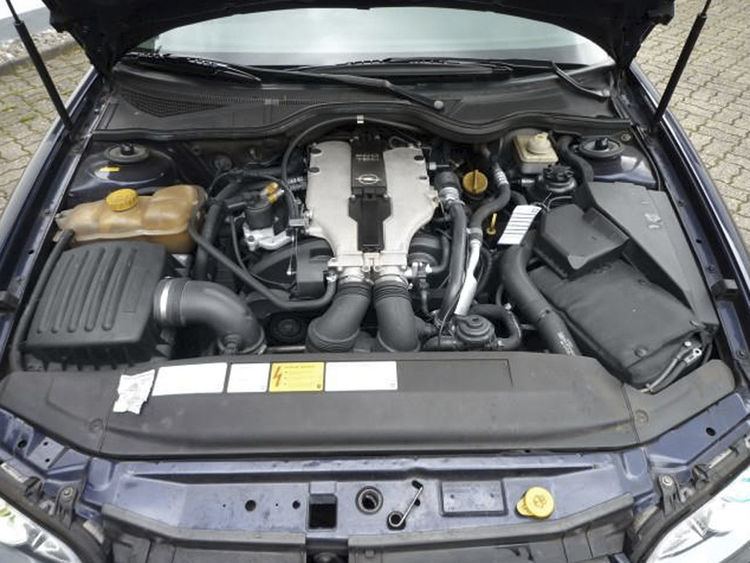Manufacturer General Motors Production 1994-2004 | Also called Ellesmere V6 Configuration 54° V6 | |
 | ||
General Motors' Opel subsidiary in Europe designed a compact V6 engine with an unusual 54° vee angle. It was an iron block/aluminum head DOHC design with 4 valves per cylinder. All 54° engines were assembled at Ellesmere Port in England.
Contents
History
In the early 1990s, Opel identified the need for a modern, lightweight and compact power plant to replace its ageing straight-6 engine range. These engines have a cast iron engine block with cast aluminium alloy cylinder heads. The cylinder heads contain 4 valves per cylinder actuated by dual overhead camshafts which are driven by a timing belt. These engines however, differed from many modern V6 engines in that it has a 54 degree cylinder bank angle; as opposed to the more conventional 60 degree setup. This added to the engines' compactness which was needed to allow its use in front-wheel drive applications, as well as rear-wheel drive cars. Other features of these engines include: an oil to water heat exchanger is mounted within the V of the engine block, Bosch Motronic engine management system with full sequential fuel injection, knock control on each bank, distributorless ignition system (DIS), and closed loop lambda control.
Minor changes were made to the unit during its production, including an uprated oil pump around mid-1997, with the addition of larger oilways in the head machining (T-Vents), and modified valve lifters to reduce top-end valve noise, at which point the cam belt arrangement also changed with the lower idler moving. Around 1998, the spin-on metal canister oil filter was changed to a disposable paper element.
Revision
The engine was reworked substantially in 2000 in order to meet increasing emission requirements; with the 2.5 and 3.0 being replaced by lower compression 2.6 and 3.2 units. While displacement was changed the bore centers and deck height were retained. These later power plants had a revised engine management system setup, which utilised quad lambda sensor control, coil per plug ignition system and drive by wire throttles. The 3.2 also received a stronger steel crankshaft. As a result of these changes the EGR and secondary air injection system were removed.
Recalls
In its 3.0 L form, this engine was notable for recalls of all units installed in Cadillac Cateras due to timing belt tensioner bearing failures, which could cause catastrophic damage to the engine because of its interference design.
2.5
The C25XE or B258I has an 81.6 mm (3.213 in) bore with a 79.6 mm (3.134 in) stroke and displaces 2,498 cc (152.4 cu in). It produces a Deutsches Institut für Normung (DIN) rated output of 125 kW (170 PS; 168 bhp), and generates 227 N·m (167 lbf·ft) of torque. It was introduced in the Opel Vectra/Vauxhall Cavalier (both codenamed "Vectra-A") and Opel/Vauxhall Calibra. It features Bosch Motronic 2.8 engine management.
For 1994, in order to meet more stringent emission requirements, a secondary air injection system, and an EGR valve were added to the C25XE and became the X25XE.
The breakdown of the engine name is as follows:
X - Exhaust Emissions Level: 94/12/EC, stage 2
25 - 2.5 Litre displacement
X - Compression Ratio - 10.0-11.5:1
E - Mixture System - Injection
Applications:
MSD version
A special edition of the X25XE was worked by Motor Sports Developments (MSD); which includes reprofiled camshafts, giving the engine a boost of 24 bhp (18 kW). This engine appeared in two special edition Vauxhall Vectras, first the Vectra ST200 (Not the normal SuperTouring), and then the Vectra 2.5 GSi V6.
Applications:
3.0
The X30XE, L81, or B308I has a 86 mm (3.386 in) bore with a 85 mm (3.346 in) stroke and displaces 2,962 cc (180.8 cu in) with a compression ratio between 10.0:1 and 10.8:1 . The engine produces, between 170 hp (127 kW) and 178 hp (133 kW) with 184 lb·ft (249 N·m) to 199 lb·ft (270 N·m). The B308I is a slightly modified X30XE used in the SAAB 9000.
X - Exhaust Emissions Level: 94/12/EC, stage 2
30 - 3.0 Litre displacement
X - Compression Ratio - 10.0-11.5:1
E - Mixture System - Injection
Applications:
B308
For 1997, Saab introduced a turbocharged version called the B308 for their 9-5 model. The engine produced 200 hp (149 kW) at 5000 rpm and 229 lb·ft (310 N·m) of torque at 2500-4000 rpm. The engine was unique in that it used asymmetrical turbocharging; with the turbocharger driven by the exhaust gases from only one bank of cylinders. A charge pressure of 3.6 PSI (0.25 bar) was produced using a Garrett GT15 turbo. The engine was equipped with a special version of Saab Direct Ignition and utilized the Trionic T7 engine management system.
Applications:
2.6
This engine was used in:
3.2
The 3.2 L LA3 or Y32SE is a complete redesign of the L81 for the Cadillac CTS and Opel Omega B. It had with fixed (non-variable) valve timing, and a variable length intake manifold. The engine has a 87.5 mm (3.445 in) bore and a 88 mm (3.465 in) stroke with a 10.0:1 compression ratio. This was a 3,175 cc (193.8 cu in) engine and produced 220 hp (164 kW) at 6000 rpm and 220 lb·ft (298 N·m) at 3400 rpm. Production started in July 2001, but the engine was replaced by the new GM High Feature engine starting in 2004.
This engine was used in:
